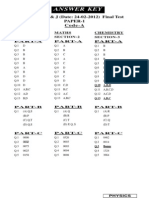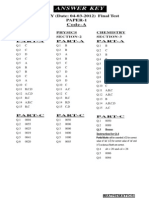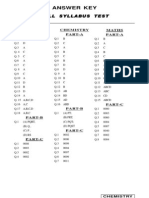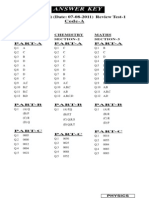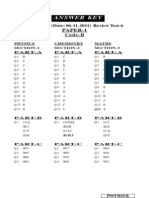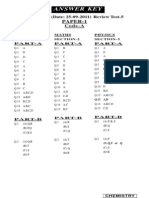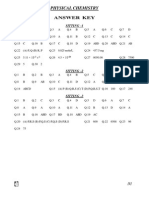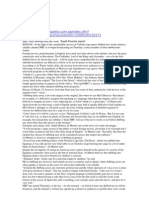Answer Key: 13 VXY (Date: 13-11-2011) Review Test-4 Paper-2
Answer Key: 13 VXY (Date: 13-11-2011) Review Test-4 Paper-2
Uploaded by
vishal110085Copyright:
Available Formats
Answer Key: 13 VXY (Date: 13-11-2011) Review Test-4 Paper-2
Answer Key: 13 VXY (Date: 13-11-2011) Review Test-4 Paper-2
Uploaded by
vishal110085Original Description:
Original Title
Copyright
Available Formats
Share this document
Did you find this document useful?
Is this content inappropriate?
Copyright:
Available Formats
Answer Key: 13 VXY (Date: 13-11-2011) Review Test-4 Paper-2
Answer Key: 13 VXY (Date: 13-11-2011) Review Test-4 Paper-2
Uploaded by
vishal110085Copyright:
Available Formats
13
th
VXY (Date: 13-11-2011) Review Test-4
PAPER-2
Code-A
ANSWER KEY
PHYSICS
SECTION-2
PART-A
Q.1 D
Q.2 B
Q.3 D
Q.4 A
Q.5 C
Q.6 A
Q.7 B,C,D
Q.8 C,D
Q.9 B,C
Q.10 A,B,C,D
Q.11 A,C
Q.12 A,B
Q.13 B,D
PART-B
Q.1 (A) Q
(B) P,R
(C) S
PART-C
Q.1 0020
Q.2 0020
Q.3 0012
Q.4 0050
Q.5 0018
CHEMISTRY
SECTION-1
PART-A
Q.1 A
Q.2 C
Only XY Batch
Q.3 D
Only V-Group Batch
Q.3 A
Q.4 B
Q.5 D
Q.6 C
Q.7 A
Q.8 D
Q.9 B
Only For V & Y Batches
Q.10 A,B,C
Only For X Batches
Q.10 A,B,C
Q.11 A,B,C
Q.12 A,D
Q.13 A,C
PART-B
Q.1 (A) Q,R
(B) P,Q,R,S
(C) P,Q,R,S
PART-C
Q.1 0087
Q.2 3100
Q.3 0005
Q.4 2005
Q.5 6080
MATHS
SECTION-3
PART-A
Q.1 A
Q.2 C
Q.3 C
Q.4 D
Q.5 D
Q.6 D
Q.7 A,C,D
Q.8 A,C
Q.9 A
Q.10 B,D
Q.11 B,C,D
Q.12 A,C
Q.13 C,D
PART-B
Q.1 (A) S
(B) P
(C) P
PART-C
Q.1 0217
Q.2 0001
Q.3 0004
Q.4 0064
Q.5 0020
Code-A Page # 1
CHEMISTRY
PART-A
Q.1
[Sol. Weight of 1 proton =
A
N
1
Weight of 1 mole proton = 1
Number of Moles of proton =
1
1000
= 10
3
Ans. ]
Q.2
[Sol.
COOH
NaOH
COONa
A
CaO
+ CO
2
]
Only XY Batch
Q.3
[Sol. [M(gly)(py)(OCN) (PPh
3
)N
3
]
+2
(A) Calculation for oxidation state of central atom
x 1 + 0 1 + 0 1 = +2
x = + 5 Oxidation of central atom
(B) [M(gly)(py)(OCN) (PPh
3
)N
3
]
+2
+
[M(AB)cdef]
2+
Coordination number = 6
(C) [M(AB)cdef] 12 Geometrical isomers are possible
(D) [M(gly)(py)(OCN) (PPh
3
)N
3
]
+2
and Both complexes are linkage isomers of each other.
[M(gly)(py)(NCO) (PPh
3
)N
3
]
+2
]
Only V-Group Batch
Q.3
[Sol. Hg, Cu and Pb metals can be extracted by self reduction from their respective sulphide ores.]
Q.4
[Sol.
dV
dP
=
|
.
|
\
|
V
P
increases slope decreases]
Code-A Page # 2
CHEMISTRY
Q.5
[Sol. Rate of nucleophilic attack o Electrophilic nature of carbonyl ]
Q.6
[Sol. (A)
B
F
F
F
F
perfectly sp
3
(B)
Si
F
F
F
F
perfectly sp
3
(C)
C
F
F
F
F
%s
%s
%s
%s
imperfectly sp
3
(D)
C
Cl
Cl
Cl
Cl
perfectly sp
3
]
Paragraph for question nos. 7 to 9
[Sol.
KOH
A
MnO
A
KOH
A
H O
3
+
Red
B
l
u
e
l
i
t
m
u
s
HCOCH=CH
2
HCOH
HCH
O O
O
+ CH = CHOH CH CHO
2 3
(B)
(A)
(C)
CH CH=CHCHO
3
CH OH+HCOONa
3
(Aldol condensation)
(Cannizaro reaction)
]
Only For X Batches
Q.10
[Sol. C
A
+ C
B
+ C
C
=
0
A
C
0
dt
dC
dt
dC
dt
dC
C B A
= + +
2
1
C
A
k
k
C
C
=
) k k (
k
C C
C
2 1
1
A A
B
0
+
=
]
Code-A Page # 3
CHEMISTRY
Q.11
[Sol. (A)
OH
|
CH CH CH
3 3
+
2
I NaOH
O
| |
CHI ONa C CH
3 3
+
(B)
C CH
3
O
+
2
I NaOH
COONa
+ CHI
3
(C) CH
3
CH
2
Cl
+
2
I NaOH
CHI
3
+ HCOONa
(D)
O
| |
OH C Me
+
2
I NaOH
MeCOONa ]
Q.12
[Sol. +2 +2
[PtCl(NH
3
)
3
][Cu(NH
3
)Cl
3
]
Triammine chlorido platinum (II)ammine trichlorido cuprate (II)
or
[PtCl(NH
3
)
3
]
+
[Cu(NH
3
)Cl
3
]
Triammine chlorido platinum (+1)ammine trichlorido cuprate (1) ]
Q.13
[Sol. (A) AH = AH
1
+ AH
3
AH
2
= (12830 + 1227013680)
= 11420 Cal.
(B) AH
2
AH
1
= 13680 12830
= 850 Cal.
(C) AH
2
AH
3
= 13680 12270
= 1410 Cal.
(D) H
2
O H
+
+ OH
= + 13680 K ]
PART-B
Q.1
[Sol. (A) [Co(NH
3
)
5
Cl]
2+
[Ma
5
b]
No. G.I.
C.No. = 6
EAN = 27 3 + 12 = 36
No. Linkage isomersim (Due to absence of ambidentate ligand.
(B) [Co(NH
3
)
4
(CN)
2
]
+
[Ma
4
b
2
]
Two GI's are possible
C.No. = 6
EAN = 27 3 + 12 = 36
Shows linkage isomersm
(Because ambidentate ligand (CN
) is present)
(C) [Co(NH
3
)
2
(NO
2
)
4
]
1
[Ma
2
b
4
]
Code-A Page # 4
CHEMISTRY
Two GI's are possible
C.No. = 6
EAN = 27 3 + 12 = 36
Shows linkage isomersm
(Because ambidentate ligand (NO
2
) is present) ]
PART-C
Q.1
[Sol. B
2
(H
2
PtCl
6
)
3
A
Pt
By POAC of Pt
Pt of mass Atomic
Pt of . wt
salt of mass Mole
slat of . wt
3 =
195
1
salt of mass Mole
4 . 2
3 =
Mole mass of salt = 3 2.4 195 = 1404
Mass of base =
2
410 3 M
salt
=
2
410 3 1404
= 87 Ans. ]
Q.3
[Sol. BeO , ZnO, PbO, Al
2
O
3
, SnO
are amphoteric oxides ]
Q.4
[Sol. Decomposition of H
2
O
2
is first order
and its t
1/2
can be calculated as
2t
1/2
= 40 sec
t
1/2
= 20 sec
t
1/2
= 60 sec 3t
1/2
volume required =
2
10
= 5 ml
abcd = 2005 Ans. ]
Q.5
[Sol. 0 H
f
= A
for Br
2
(l)
(1) + (2) + (3) + (4) + (5)
0 + 2057 + 3015 + 0 + 1008 = 6080 Ans. ]
PHYSICS
Code-A Page # 1
PART-A
Q.1
[Sol. Q = ne ]
Q.2
[Sol.
R
kQ
= V
Q =
k
VR
o =
2
R 4
Q
t
=
2
kR 4
VR
t
o
R
1
]
Q.3
[Sol. U
i
+ K
i
= U
f
+ K
f
0 + 200 = 100 + 1.5 10 h
h =
15
100
=
3
20
m ]
Q.4
[Sol. kx = me
2
(l
0
+ x)
5
100
5
= 1 1 (l
0
+ 0.05)
100
25
= l
0
+
100
5
l
0
= 20 cm ]
Q.5
[Sol.
dt
dT
=
ms
CA
(T T
0
) =
s R
3
4
R 4 C
3
2
t
t
(T T
0
)
R
1
2
R
R
dt
dT
dt
dT
P
Q
Q
P
= =
]
Q.6
[Sol.
Q Q
E = 0 ; V = 0 ]
Q.8
[Sol. v cos o = v
0
v sin o =
m
qE
t
t =
0
v
a
PHYSICS
Code-A Page # 2
v sin o =
0
a
mv
qE
L
d
= tan o =
0
0
a
v
mv
qE
=
2
0
a
mv
qE
d = 2
0
a
mv
L qE
]
Q.10
[Sol. collision is elastic
'
2
p = p
1
= 3kg m/s
collision is inelastic
'
1
'
2
p p = = 1.5 kg m/s for other cases p is in between. ]
Q.11
[Sol. F = 4a
37
F
N
1g
F sin 37 + N cos 37 = 10
F cos 37 N sin 37 = 1a
3 3F + 4N = 50
4 4F 3 N = a
25F = 150 + 4a
100 a 4a = 150
a =
96
150
F
8
=
96
150
4 = 6.25 N ]
Q.13
[Sol. v =
0
2e
o
(O y)
O
o
y
x
z
=
0
2
y
e
o
=
2
y
]
PART-C
Q.1
[Sol. F = mg sin u ~ mg tan u
mg
u
tan u =
dx
dy
= 40 x
me
2
x = mg 40 x
e =
400
= 20 rad/s ]
Q.2
[Sol. e =
60
2 60 t
rad/s = 2t rad/s
0 = e
0
ot
o =
40
2t
=
20
t
PHYSICS
Code-A Page # 3
t = Io = 40t
20
t
= 2t
2
~ 20 Nm ]
Q.3
[Sol. v = 0 at a point between both charges and to left of 2q.
4 x
2q 3q
9
x
q 2 k
x 5
kq 3
= 0
10 2x = 3x
x = 2
to left of 2q,
y
2q 3q
y
q 2 k
y 5
kq 3
+
= 0
10 + 2y = 3y
y = 10 distance = 12 m ]
Q.4
[Sol. 11.25 = x tan u
2
1
2
2
20
x 10
(1 + tan
2
u)
11.25 = x tan u
80
x
2
80
x
2
tan
2
u
80
x
2
tan
2
u + x tan u
80
x
2
+ 11.25 = 0
b
2
4 ac > 0
80
x
x 4 x
2
2
+
0 25 . 11
80
x
2
>
|
|
.
|
\
|
+
1 +
20
1
|
|
.
|
\
|
80
x
25 . 11
2
> 0
20
25 . 31
>
1600
x
2
x
2
> 312.5 8 = 625 4
x s 50 m ]
Q.5
[Sol.
5 . 15
1
= (1.504 1)
|
|
.
|
\
|
2 1
R
1
R
1
f
1
= (1.434 1)
|
|
.
|
\
|
2 1
R
1
R
1
5 . 15
f
=
434 . 0
504 . 0
f = 15.5
217
252
= 18 cm ]
MATHEMATICS
Code-A Page # 1
PART-A
Q.1
[Sol. I = }
+
e
1
) x n 1 ( nx x
dx
l l
Put 1 + ln x = t
2
I =
}
2
1
2
1 t t
dt t 2
= 2 ( ) 1 2 n + l = ( ) 2 2 3 n + l . Ans.]
Q.2
[Sol.
MB
f(x) = min. ( ) 1 x , 1 x + + = x + 1 x e R
x
y
y
=
x
+
1
y = x + 1
O(0,0)
]
Q.3
[Sol. If f (x) < 0 then | f (x) | = f (x)
Hence, f (x) > f (x) is not possible.
If f (x) > 0 then | f (x) | = f (x)
Hence, f (x) > f (x)
2 f (x) > 0 f (x) > 0 x
2
4x + 3 > 0 x e ( , 1) (3, ). Ans.]
Q.4
[Sol. As, AA
1
= I =
(
1 0
0 1
u u
u
2 2
2
sin sin
0 sin 2
(
2 1
0 1
=
(
1 0
0 1
u
u
2
2
sin 2 0
0 sin 2
=
(
1 0
0 1
2 sin
2
u = 1 sin
2
u =
2
1
= sin
2
4
t
u = nt
4
t
, n e I
Hence, number of values of u in [ t, t] is 4 i.e.
4
3
,
4
t
Ans. ]
Q.5
[Sol. We have
x
2
+ 2cx + b = 0
o
|
and
x + 2bx + c = 0
2
So, o
2
+ 2co + b = 0 .........(1)
and o
2
+ 2bo + c = 0 ........(2)
(Subtracting)
2(c b) o = (c b)
MATHEMATICS
Code-A Page # 2
As, b = c so o =
2
1
Now, putting o =
2
1
in equation (1), we get
0 b
2
1
c 2
2
1
2
= +
|
.
|
\
|
+
|
.
|
\
|
4
1
+ c + b = 0
Hence, (b + c) =
4
1
. Ans.]
Q.6
Sol. Let ZABD = u and ZB = 45.
2
1
BD BA sinu =
3
2
1
BD BC sin (45 u)
BC
BA
sinu =
2
3
(cos u sin u)
75
45u
60
C
D
A
B
u
75 sin
60 sin
sinu =
2
3
cos u
2
3
sin u
( ) 3 1 +
3
sinu =
( ) 3 1 +
cosu
tanu =
3
1
u = 30 e
|
.
|
\
| t t
4
,
8
]
Paragraph for question nos. 7 to 9
[Sol. ( ) ) x ( f f = a
3
|
.
|
\
|
+ +
a
2
b 2 x ) b 2 ( x
2
|
.
|
\
|
+ +
a
b
b 2 x ) b 2 ( x
2
, a = 0
Now, we shall consider 3 cases:
Case I: When x (2 + b)x +
2
5 5
|
.
|
\
|
a
2
b 2
= 0
2 + b = 10 b = 8
O(0,0)
X
Y
(2,0) x = 5 (8,0)
Graph of f(x) = (x 2)(x 8)
9
2
(x = 5, y = 2)
|
.
|
\
|
9
32
, 0
Also, 2b
a
2
= 25 16 25 =
a
2
a =
9
2
Let, D = discriminant of
(
+ +
a
b
b 2 x ) b 2 ( x
2
MATHEMATICS
Code-A Page # 3
= (2 + b)
2
4
|
.
|
\
|
a
b
b 2
= (2 + 8)
2
8 8 +
9 / 2
8 4
= 100 64 144 < 0
So, f(x) =
9
2
(x 2) (x 8) =
9
2
(x 5)
2
+ 2
Case II: When x (2 + b)x +
2
5 5
|
.
|
\
|
a
b
b 2 = 0
2 + b = 10 b = 8
16 25 =
a
8
a =
9
8
Let D' = discriminant of |
.
|
\
|
+ +
a
2
b 2 x ) b 2 ( x
2
= (2 + b)
2
4 |
.
|
\
|
a
2
b 2
= (2 + 8)
2
8 8 +
9 / 8
8
= 100 64 9 > 0. So, above case is rejected.
Case III : When, x (2 + b)x +
2
5 5
|
.
|
\
|
a
2
b 2
= 0 and x (2 + b)x +
2
5 5
|
.
|
\
|
a
b
b 2
= 0
But, it is not possible for any real value of a and b. So, this possibility is also rejected.
We conclude that f(x) =
9
2
(x 2) (x 8)
(i) From above graph of f(x), we can say that the maximum value of f(x) is 2 and attained at x = 5.
(ii) Let the line passing through O(0, 0) be y = mx.
Solving y = mx and y =
9
2
(x 5)
2
+ 2 ; we get
mx =
9
2
(x 5)
2
+ 2 9mx = 2(x
2
10x + 25) + 18 2x
2
+ (9m 20)x + 32 = 0
As, y = mx is tangent line, so put D = 0
(9m 20)
2
= 4 2 16 (9m 20) = 16 9m = 20 16 m =
9
36
,
9
4
m = 4,
9
4
Ans.
(iii)
}
5
2
dx ) x ( f =
}
|
.
|
\
|
+
5
2
2
dx 2 ) 5 x (
9
2
=
5
2
3
3
) 5 x (
9
2
(
+ 6 =
27
2
(0 + 27) + 6 = 2 + 6 = 4 Ans.]
MATHEMATICS
Code-A Page # 4
Q.10
[Sol. P = sin 25 sin 35 sin 60 sin 85
= sin 25 sin (60 25) sin 60 sin (60 + 25)
= sin 60 sin 25 sin (60 25) sin (60 + 25)
P = sin 60
4
1
sin 75 .......(1)
Q = sin 20 sin 40 sin 75 sin 80 = sin 20 sin (60 20) sin 75 sin (60 + 20)
= sin 75 sin 20 sin (60 20) sin (60 + 20)
Q = sin 75
4
1
sin 60 .......(2)
Hence P = Q (B) and (D) ]
Q.11
[Sol. P
1
: x + 3y + 2z = 6
P
2
: x + ay + 2z = 7
P
3
: x + 3y + 2z = b
Note that the planes P
1
and P
3
are parallel hence system of equation will never have unique solution.
If b = 6 and a = 4 then P
1
and P
3
are identical and P
2
will intersect P
1
and P
3
at infinite number of
points because they have common line of intersection.
If b = 6, then P
1
and P
3
are parallel and system will have no solution for every a e R.
Alternatively:
Given, x + 3y + 2z = 6 ........(1)
x + ay + 2z = 7 ........(2)
x + 3y + 2z = b ........(3)
(A) If a = 2, then A = 0 so unique solution is not possible. (A) is incorrect.
(B) If a = 4, b = 2; consider the equation (1) and (2), we get
x + 3y = 6 2z
x + 4y = 7 2z
y = 1 and x = 3 2z
Now, on substituting in equation (3), we get
3 2z + 3 + 2z = 6, (True)
infinite solution exists. (B) is correct.
(C) If a = 5, b = 7 ; consider the equation (2) and (3), we get
x + 5y = 7 2x
x + 3y = 7 2x
y = 0 and x = 7 2x
Now, on substituting in equation (1), we get
7 2z + 2z = 6 (False)
No solution exists. (C) is correct.
(D) If a = 3, b = 5 then equation (1) and (2) have no solution No solution exists. (D) is correct.]
MATHEMATICS
Code-A Page # 5
Q.12
[Sol.
mb
We have f(x) 2
) say ( A
4
0
5
2
dt ) t ( f t cos
x cos
x sin
}
t
=
x cos
x sin
5
2
f (x) 2A
x cos
x sin
5
2
=
x cos
x sin
5
2
f (x) = (2A + 1)
x cos
x sin
5
2
......(1)
Now, A =
}
t
+
4
0
5
2
dt
t cos
t sin
) 1 A 2 ( t cos =
}
t
+
4
0
4
2
dt
t cos
t sin
) 1 A 2 ( =
}
t
+
4
0
2 2
dt t sec t tan ) 1 A 2 (
Put tan t = y sec
2
t dt = dy
we get A = (2A + 1) }
1
0
2
dy y
= (2A + 1)
3
1
3A = 2A + 1
A = 1
Hence from equation (1), we get
f(x) =
x cos
x sin 3
5
2
(A) Cl earl y,
x cos
x sin 3
Lim ) x ( f Lim
5
2
3
x
3
x
t
=
=
5
2
2
1
2
3
3
|
.
|
\
|
|
|
.
|
\
|
= 72 Ans.
(B) As, f(x) =
x cos
x sin 3
5
2
So, f (x) is periodic with period 2t.
(C) f(x) =
x cos
x sin 3
5
2
f ' (x) =
(
+
x cos
) x sin x cos 5 ( x sin ) x cos x sin 2 ( x cos
10
4 2 5
f ' (t) = 0
M (x = t, y = 0)
So, equation of normal to the graph of f (x) at point M whose abscissa is t, is given by x t = 0
(D) As, f (x) = 0
x cos
x sin 3
5
2
= 0 sin x = 0
MATHEMATICS
Code-A Page # 6
x = nt, n e I
So, the equation f (x) = 0 has no root in (0, 3). ]
Q.13
[Sol.
(A) The above statement is false because A
1
exist only when det. (A) = 0.
(B) The above statement is false. As, det. (A B
1
) = det. (A) det. (B
1
) =
) B ( . det
) A ( . det
=
2
6
= 3.
(C) Given, A =
(
(
1 1 1
1 1 1
1 1 1
AA
2
=
(
(
3 3 3
3 3 3
3 3 3
= 3A.
A
3
= 3A
2
A
3
= 3(3A) A
3
= 9A. So, this statement is correct.
(D) Given, A
2
= A and B = I A
Now, AB + BA + I ( I A)
2
= AB + BA + I (I + A
2
2A) = AB + BA + A (As, A
2
= A)
= A(I A) + (I A) A + A = A A + A A + A = A (As, A
2
= A and B = I A)
So, this statement is correct. Ans.]
PART-B
Q.1
Sol.(A) Given, 2a sin x a sin 3x s 6 x e R
or, a [2sin x (3sin x 4sin
3
x)] s 6
or, a sin x (4sin
2
x 1) s 6 x e R
As, maximum value of a sin x (4sin
2
x 1) is 3 | a |.
So, we must have 3 | a | s 6 | a | s 2
So, possible integral values of a are 2, 1, 0, 1, 2.
Hence, number of integral values of a are 5.
(B) x
2
+ 2x sin (xy) + 1 = 0 (As, x = 0)
Dividing by x, we get ) xy sin( 2
x
1
x = +
which is possible when x = 1 and y =
2
t
or x = 1 and y =
2
t
.
Hence total number of ordered pairs (x, y) is 2. Ans.
(C) L =
( ) ( )
3 2 3 1
x
0
2
0 x
x 2 1 n x sin
dt t cos
Lim
+
}
l
=
( )
3 2
3 2
3 1
3 1
x
0
2
0 x
x 2
x 2 1 n
x
x sin
dt t cos
Lim
+
}
l
=
x 2 1 1
dt t cos
Lim
x
0
2
0 x
}
=
2
1 x cos
Lim
2
0 x
=
2
1
L
1
= 2]
MATHEMATICS
Code-A Page # 7
PART-C
Q.1
[Sol. S
n
=
2
1 3
n
; S
n + 1
=
2
1 3
1 n
+
T
n
= 5 5
n 1
T
n + 2
= 5
n + 2
= +
+
1 n 2 n
1 n
T
S
=
=
|
|
.
|
\
|
1 n
n
n
25 5 2
1 3 3
=
=
=
|
.
|
\
|
1 n
n
1 n
n
5
1
50
1
5
3
50
3
=
5
1
1
5
1
50
1
5
3
1
5
3
50
3
=
4
1
50
1
2
3
50
3
=
200
1
200
18
=
200
17
Ans.]
Q.2
[Sol. As,
( )
) C .( det
B . adj . det
=
( ) ( )
) A 5 .( det
B . adj . adj . det
=
( ) ( )
( )
) A .( det 5
A . adj
3
1 3
2
=
125
A
3
.
As, det. (A) = 5
So,
) C ( . det
) B . adj .( det
=
( )
125
5
3
= 1. Ans.]
Q.3
Sol. Let I =
}
t
t
+ +
4
65
4
x sin x cos
) 2 1 )( 2 1 (
dx
=
}
t
+ t
t
+ +
4
16
4
x sin x cos
) 2 1 )( 2 1 (
dx
=
}
t
t =
+ +
16
0
2 period with periodic
x sin x cos
) 2 1 )( 2 1 (
dx
=
}
t
+ +
2
0
x sin x cos
) 2 1 )( 2 1 (
dx
8
= 8I
1
where I
1
=
}
t
+ +
2
0
x sin x cos
) 2 1 )( 2 1 (
dx
Using King and add
2I
1
=
}
t
+
2
0
x cos
) 2 1 (
dx
MATHEMATICS
Code-A Page # 8
Again using King and add
4I
1
=
}
t 2
0
dx = 2t
Hence I
1
=
2
t
I = 8I
1
= 8
2
t
= 4t kt. Hence k = 4. Ans.]
Q.4
[Sol. I
n
= ( )
}
+
1
0
n
I
2
II
dx x 1 1 = ( ) ( )
}
+ +
1
0
2
1 n
2
1
0
n
2
dx x x 1 n 2 x x 1
= 2
n
2n ( )
}
+ +
1
0
2
1 n
2
dx ) 1 x 1 ( x 1
I
n
= 2
n
2n
( ) ( )
(
(
+ +
} }
1
0
1 n
2
1
0
n
2
dx x 1 dx x 1
I
n
= 2
n
2n I
n
+ 2n I
n1
(2n + 1) I
n
= 2
n
+ 2n I
n1
or (2n + 1) I
n
2n I
n1
= 2
n
Put n = 6,
13 I
6
12 I
5
= 2
6
= 64. Ans.]
Q.5
[Sol. We have g(x) =
(
+
+
2
1
x 1
x 2
sin 2
= 2 +
(
2
1
x 1
x 2
sin
As, sin
1
2
x 1
x 2
+
e
(
t t
2
,
2
2
1
x 1
x 2
sin
= 2, 1, 0, 1.
Range of g(x) = {0, 1, 2, 3} for ( ) ) x ( g f < 0 x e R
f(0) < 0 and f(3) < 0
Now, f(0) < 0 a 2 < 0 a < 2
and f(3) < 0 9 6a + a 2 < 0
a >
5
7
0 1 2 3
x-axis
f(x) = x 2ax a 2
2
a e
|
.
|
\
|
2 ,
5
7
.
Hence, k
1
=
5
7
, k
2
= 2
(10k
1
+ 3k
2
) = 14 + 6 = 20. Ans.]
You might also like
- SMART VocabularyDocument49 pagesSMART VocabularyNidraf Gaming0% (1)
- Answers Level9-10Pack6Document22 pagesAnswers Level9-10Pack6David TurnerNo ratings yet
- Activity Completion Report (ACR) On Kick Off "School-Based Brigada Eskwela" S.Y. 2021-2022Document6 pagesActivity Completion Report (ACR) On Kick Off "School-Based Brigada Eskwela" S.Y. 2021-2022Erma Rose Hernandez100% (1)
- Vaults OF Vaarn: L E O H U N TDocument50 pagesVaults OF Vaarn: L E O H U N Tmacaquinho.100% (4)
- Answer Key: 13 VXY (Date: 18-12-2011) Review Test-5 Paper-2Document15 pagesAnswer Key: 13 VXY (Date: 18-12-2011) Review Test-5 Paper-2vishal110085No ratings yet
- Answer Key: 11 PQRS (Date: 25-12-2011) Review Test-7 Paper-1Document13 pagesAnswer Key: 11 PQRS (Date: 25-12-2011) Review Test-7 Paper-1vishal27042233No ratings yet
- RT Solutions-IITJEE J XI RT 2 2012-08-12 Paper I Code A SolDocument12 pagesRT Solutions-IITJEE J XI RT 2 2012-08-12 Paper I Code A Solvishal110085No ratings yet
- Answer Key: 13 VXY (Date: 12-02-2012) Review Test-7 Paper-1Document18 pagesAnswer Key: 13 VXY (Date: 12-02-2012) Review Test-7 Paper-1vishal110085No ratings yet
- Answer Key: Paper-1Document15 pagesAnswer Key: Paper-1vishal110085No ratings yet
- Answer Key: Paper-1Document15 pagesAnswer Key: Paper-1vishal110085No ratings yet
- RT Solutions-24!02!2012 XI PQRS J Paper I Code ADocument16 pagesRT Solutions-24!02!2012 XI PQRS J Paper I Code Avishal110085No ratings yet
- Answer Key: 11 J (Date: 25-12-2011) Review Test-6 Paper-1Document13 pagesAnswer Key: 11 J (Date: 25-12-2011) Review Test-6 Paper-1vishal110085No ratings yet
- Answer Key: 11 PQRS & J (Date: 25-02-2012) Final Test Paper-2Document13 pagesAnswer Key: 11 PQRS & J (Date: 25-02-2012) Final Test Paper-2Ħāŕsh ĦOt Çūŕšēd PrîñçêNo ratings yet
- RT Solutions-25!09!2011 XII ABCD Paper I Code BDocument17 pagesRT Solutions-25!09!2011 XII ABCD Paper I Code Bvishal27042233No ratings yet
- Answer Key: Special TEST-2 1 5 - 0 1 - 2 0 1 2Document15 pagesAnswer Key: Special TEST-2 1 5 - 0 1 - 2 0 1 2vishal110085No ratings yet
- 04 03 2012 XIII VXY Paper I Final Test Code A SolDocument19 pages04 03 2012 XIII VXY Paper I Final Test Code A Solvishal110085No ratings yet
- RT Solutions-25!09!2011 XII ABCD Paper II Code BDocument17 pagesRT Solutions-25!09!2011 XII ABCD Paper II Code Bvishal110085No ratings yet
- Answer Key: 13 VXY (Date: 13-11-2011) Review Test-4 Paper-1Document20 pagesAnswer Key: 13 VXY (Date: 13-11-2011) Review Test-4 Paper-1vishal110085No ratings yet
- Answer Key: 11 PQRS (Date: 20-11-2011) Review Test-6 Paper-1Document13 pagesAnswer Key: 11 PQRS (Date: 20-11-2011) Review Test-6 Paper-1vishal110085No ratings yet
- Answer Key: Full Syllabus TestDocument12 pagesAnswer Key: Full Syllabus TestchakshuishanNo ratings yet
- RT Solutions-18!12!2011 XIII VXY Paper I Code ADocument17 pagesRT Solutions-18!12!2011 XIII VXY Paper I Code Avishal110085No ratings yet
- RT Solutions-25!09!2011 XII ABCD Paper II Code ADocument17 pagesRT Solutions-25!09!2011 XII ABCD Paper II Code Avishal110085No ratings yet
- Answer Key: 11 PQRS (Date: 10-07-2011) Review Test-2 Paper-1Document11 pagesAnswer Key: 11 PQRS (Date: 10-07-2011) Review Test-2 Paper-1vishal110085No ratings yet
- Answer Key: 11 (J7 & J8) (Date: 07-08-2011) Review Test-1Document11 pagesAnswer Key: 11 (J7 & J8) (Date: 07-08-2011) Review Test-1vishal110085No ratings yet
- 12 06 2011 Xii Abcd Paper II Code BDocument14 pages12 06 2011 Xii Abcd Paper II Code Bvishal110085No ratings yet
- Answer Key: 12 ABCD (Date: 06-11-2011) Review Test-6Document17 pagesAnswer Key: 12 ABCD (Date: 06-11-2011) Review Test-6vishal27042233No ratings yet
- Answer Key: Paper-1Document16 pagesAnswer Key: Paper-1vishal110085No ratings yet
- Answer Key: 11 PQRS (Date: 05-06-2011) Review Test-1Document14 pagesAnswer Key: 11 PQRS (Date: 05-06-2011) Review Test-1vishal110085No ratings yet
- Answer Key: Paper-2Document14 pagesAnswer Key: Paper-2vishal110085No ratings yet
- Answer Key: 11 PQRS (Date: 05-06-2011) Review Test-1Document14 pagesAnswer Key: 11 PQRS (Date: 05-06-2011) Review Test-1vishal110085No ratings yet
- Answer Key: 11 (J-6) (Date: 10-07-2011) Review Test-1Document10 pagesAnswer Key: 11 (J-6) (Date: 10-07-2011) Review Test-1vishal110085No ratings yet
- Answer Key: Paper-2Document18 pagesAnswer Key: Paper-2vishal110085No ratings yet
- RT Solutions-08!05!2011 XII ABCD Paper II Code ADocument13 pagesRT Solutions-08!05!2011 XII ABCD Paper II Code Avishal27042233No ratings yet
- RT Solutions-17!07!2011 XII ABCD Paper II Code BDocument15 pagesRT Solutions-17!07!2011 XII ABCD Paper II Code Bvishal110085No ratings yet
- RT Solutions-22!01!2012 XIII VXY Paper I Code A SolDocument16 pagesRT Solutions-22!01!2012 XIII VXY Paper I Code A Solvishal110085No ratings yet
- Answer Key: 11 J-BATCH (Date: 16-10-2011) Review Test-4 Paper-1Document13 pagesAnswer Key: 11 J-BATCH (Date: 16-10-2011) Review Test-4 Paper-1vishal110085No ratings yet
- RT Solutions-09!10!2011 XIII VXY Paper I Code ADocument16 pagesRT Solutions-09!10!2011 XIII VXY Paper I Code Avishal27042233No ratings yet
- RT Solutions-09!10!2011 XIII VXY Paper I Code BDocument16 pagesRT Solutions-09!10!2011 XIII VXY Paper I Code Bvishal27042233No ratings yet
- RT Solutions-25!09!2011 XII ABCD Paper I Code ADocument17 pagesRT Solutions-25!09!2011 XII ABCD Paper I Code Avishal110085No ratings yet
- Answer Key: 13 VXY (Date: 12-02-2012) Review Test-7 Paper-2Document18 pagesAnswer Key: 13 VXY (Date: 12-02-2012) Review Test-7 Paper-2vishal110085No ratings yet
- RT Solutions-21!08!2011 XII ABCD Paper II Code ADocument12 pagesRT Solutions-21!08!2011 XII ABCD Paper II Code Avishal110085No ratings yet
- Iitjee P J Xi FT 1 2013-02-10 Paper II Code A SolDocument17 pagesIitjee P J Xi FT 1 2013-02-10 Paper II Code A SolShashank PathakNo ratings yet
- Target Iit-Jee: Paper - IDocument4 pagesTarget Iit-Jee: Paper - INidhi SisodiaNo ratings yet
- RT Solutions-09!10!2011 XIII VXY Paper II Code BDocument18 pagesRT Solutions-09!10!2011 XIII VXY Paper II Code Bvishal27042233No ratings yet
- Answer Key: Paper-1Document16 pagesAnswer Key: Paper-1vishal110085No ratings yet
- Paper-1: Hints & SolutionsDocument8 pagesPaper-1: Hints & SolutionsAnudeex ShettyNo ratings yet
- RT Solutions-08!05!2011 XII ABCD Paper I Code BDocument15 pagesRT Solutions-08!05!2011 XII ABCD Paper I Code Bvishal27042233No ratings yet
- Answer Key: 11 PQRS (Date: 07-08-2011) Review Test-3 Paper-1Document11 pagesAnswer Key: 11 PQRS (Date: 07-08-2011) Review Test-3 Paper-1vishal110085No ratings yet
- RT Solutions-04!09!2011 XIII VXY Paper I Code BDocument18 pagesRT Solutions-04!09!2011 XIII VXY Paper I Code Bssjatav128No ratings yet
- Answer Key: 11 J-BATCH (Date: 16-10-2011) Review Test-4 Paper-2Document14 pagesAnswer Key: 11 J-BATCH (Date: 16-10-2011) Review Test-4 Paper-2vishal110085No ratings yet
- RT Solutions-09!10!2011 XIII VXY Paper II Code ADocument18 pagesRT Solutions-09!10!2011 XIII VXY Paper II Code Avishal27042233No ratings yet
- Answer Key: 11 (J) (Date: 03-07-2011) Review Test-1Document11 pagesAnswer Key: 11 (J) (Date: 03-07-2011) Review Test-1vishal110085No ratings yet
- Answer Key: 13 VXY (Date: 04-09-2011) Review Test-2 Paper-2Document16 pagesAnswer Key: 13 VXY (Date: 04-09-2011) Review Test-2 Paper-2vishal110085No ratings yet
- Physical Chemistry: Answer KeyDocument15 pagesPhysical Chemistry: Answer Keyvishal110085No ratings yet
- 04 09 2011 Xiii Vxy Paper II Code AooooooooooooooooooooooooooDocument16 pages04 09 2011 Xiii Vxy Paper II Code Aoooooooooooooooooooooooooovishal110085No ratings yet
- RT Solutions-22!01!2012 XIII VXY Paper II Code A SolDocument16 pagesRT Solutions-22!01!2012 XIII VXY Paper II Code A Solvishal110085No ratings yet
- Answer Key: 12 ABCD (Date: 06-11-2011) Review Test-6Document19 pagesAnswer Key: 12 ABCD (Date: 06-11-2011) Review Test-6vishal110085No ratings yet
- RT Solutions-08!05!2011 XII ABCD Paper I Code ADocument15 pagesRT Solutions-08!05!2011 XII ABCD Paper I Code Avishal27042233No ratings yet
- X Xy X: 2010 HCI H2 Mathematics Preliminary Examination Paper 2 Solution QN SolutionsDocument11 pagesX Xy X: 2010 HCI H2 Mathematics Preliminary Examination Paper 2 Solution QN Solutionsnothingtodo1992No ratings yet
- scoring key 11 - set 1Document5 pagesscoring key 11 - set 1vetridhansNo ratings yet
- Mathematics: Bansal ClassesDocument19 pagesMathematics: Bansal Classessuar90No ratings yet
- Analytic Geometry: Graphic Solutions Using Matlab LanguageFrom EverandAnalytic Geometry: Graphic Solutions Using Matlab LanguageNo ratings yet
- 10+2 Level Mathematics For All Exams GMAT, GRE, CAT, SAT, ACT, IIT JEE, WBJEE, ISI, CMI, RMO, INMO, KVPY Etc.From Everand10+2 Level Mathematics For All Exams GMAT, GRE, CAT, SAT, ACT, IIT JEE, WBJEE, ISI, CMI, RMO, INMO, KVPY Etc.No ratings yet
- '"/ + & / # - % / - &/-, #/) /%. " # / - ',, ML& +. #M! '-/&'., #/N+ +/$+ +$$ ,/!, %.,/& - "/) /%/ !/ LDocument1 page'"/ + & / # - % / - &/-, #/) /%. " # / - ',, ML& +. #M! '-/&'., #/N+ +/$+ +$$ ,/!, %.,/& - "/) /%/ !/ Lvishal110085No ratings yet
- ' & (!#% P (Iq (S (HSJ Tuv (7U:) 58 V - (L K) K6Z Csijbl M - 4H K) /lba 4H Hy Iqikbl K6HjlDocument1 page' & (!#% P (Iq (S (HSJ Tuv (7U:) 58 V - (L K) K6Z Csijbl M - 4H K) /lba 4H Hy Iqikbl K6Hjlvishal110085No ratings yet
- TV) A Ua FZC 1:Scd' @C/8 Z - BC X'A, O - Iz' BV /Z' /NF Ua Op (Va ' - ' - ' V 'Document1 pageTV) A Ua FZC 1:Scd' @C/8 Z - BC X'A, O - Iz' BV /Z' /NF Ua Op (Va ' - ' - ' V 'vishal110085No ratings yet
- 20150404a 014101005Document1 page20150404a 014101005vishal110085No ratings yet
- (#$) HBG ZJDocument1 page(#$) HBG ZJvishal110085No ratings yet
- Of?D Ej CD Higal If'Ligbr K) Iialk Hlhal X/H $?, Ff'Yj: - 4 "5 !9/ + ' & (!#% Yj Pu ZL XkyreuDocument1 pageOf?D Ej CD Higal If'Ligbr K) Iialk Hlhal X/H $?, Ff'Yj: - 4 "5 !9/ + ' & (!#% Yj Pu ZL Xkyreuvishal110085No ratings yet
- Class Xii Physics Assignment 1 Unit 1Document2 pagesClass Xii Physics Assignment 1 Unit 1vishal110085No ratings yet
- Class Xii Physics Assignment 2 Unit 2Document2 pagesClass Xii Physics Assignment 2 Unit 2vishal110085No ratings yet
- Mordern Physics Type 1ggggggggggggggggggggggggggggDocument20 pagesMordern Physics Type 1ggggggggggggggggggggggggggggvishal110085No ratings yet
- Gitarattan Jindal Public SchoolDocument1 pageGitarattan Jindal Public Schoolvishal110085No ratings yet
- Class Xii English Assignment 1 The Last LessonDocument1 pageClass Xii English Assignment 1 The Last Lessonvishal110085No ratings yet
- KTG and Themodynamics Type 1gggggggggggDocument20 pagesKTG and Themodynamics Type 1gggggggggggvishal110085No ratings yet
- Study Package: Subject: PHYSICS TopicDocument7 pagesStudy Package: Subject: PHYSICS Topicvishal110085No ratings yet
- Calorimetry and Heat Transfer Type 1Document16 pagesCalorimetry and Heat Transfer Type 1Piyush GargNo ratings yet
- Review Test - 2Document16 pagesReview Test - 2vishal110085100% (2)
- 20 Probability Part 3 of 3Document4 pages20 Probability Part 3 of 3vishal110085No ratings yet
- Class Xii English Assignment 2 The Lost SpringDocument1 pageClass Xii English Assignment 2 The Lost Springvishal110085No ratings yet
- Rt-5 Printing For Y-BatchDocument24 pagesRt-5 Printing For Y-Batchvishal110085No ratings yet
- RT Solutions-Practice Test Papers XIII VXY 1 To 6 SolDocument40 pagesRT Solutions-Practice Test Papers XIII VXY 1 To 6 Solvishal110085No ratings yet
- MOWE-UNDP 2014 - Assessment of Groundwater Resources of LebanonDocument47 pagesMOWE-UNDP 2014 - Assessment of Groundwater Resources of LebanonNassif Abi AbdallahNo ratings yet
- The Big Book of PowerShell GotchasDocument54 pagesThe Big Book of PowerShell GotchaseyzxcrrfisynnnksziNo ratings yet
- Key Functions of A WMSDocument4 pagesKey Functions of A WMSRazeen AmeenNo ratings yet
- DPM Section3 HydraulicDesignDocument102 pagesDPM Section3 HydraulicDesignAym BenjNo ratings yet
- Cognitive Behavioral Therapy For Anxiety and Depression in Cancer Survivors: A Meta AnalysisDocument12 pagesCognitive Behavioral Therapy For Anxiety and Depression in Cancer Survivors: A Meta Analysischeatingw995No ratings yet
- Biasutti Surian DCFSE 2012Document8 pagesBiasutti Surian DCFSE 2012asurianNo ratings yet
- Open DEFORM™-3D. Make A New Problem Under "Problem" Directory. Problem Setup Window Will Open. Select The Ring Rolling Guiding TemplateDocument13 pagesOpen DEFORM™-3D. Make A New Problem Under "Problem" Directory. Problem Setup Window Will Open. Select The Ring Rolling Guiding Templatevincent02hk_57881301No ratings yet
- Casey Resume 11Document2 pagesCasey Resume 11api-576074477No ratings yet
- The Role of MonarchDocument15 pagesThe Role of MonarchPhạm ĐăngNo ratings yet
- Business Communication: Project by Krishna Yadav B-22Document15 pagesBusiness Communication: Project by Krishna Yadav B-22Krishna YadavNo ratings yet
- Certificate of Registration - Ohs - Sa - 01Document1 pageCertificate of Registration - Ohs - Sa - 01AlokeNo ratings yet
- Homophones Worksheet With KeyDocument2 pagesHomophones Worksheet With KeyMariam BazerbachiNo ratings yet
- Arab DubbingDocument18 pagesArab DubbingRay Gillon100% (2)
- El Temporalón Central America Hurricane WikipediaDocument10 pagesEl Temporalón Central America Hurricane WikipediaG FuNo ratings yet
- Soal Kls11 B Ing Uts 20182019Document2 pagesSoal Kls11 B Ing Uts 20182019Dwi YuniwatiNo ratings yet
- BIÊN DỊCH 3Document39 pagesBIÊN DỊCH 3Huynh Minh KyNo ratings yet
- Cubes Cuboids Surface Area NetsDocument5 pagesCubes Cuboids Surface Area NetsCatalin SapariucNo ratings yet
- No Homework in FranceDocument6 pagesNo Homework in Franceafeutvfeg100% (1)
- Tobacco & Smoking - HuqqaDocument45 pagesTobacco & Smoking - HuqqaThe 18th Century Material Culture Resource Center100% (1)
- Ripper Tip D11Document2 pagesRipper Tip D11Max SashikhinNo ratings yet
- Efb Jaa ApprovalDocument56 pagesEfb Jaa ApprovalshotguntigerNo ratings yet
- Semi-Detailed Lesson Plan in Mathematics 8Document2 pagesSemi-Detailed Lesson Plan in Mathematics 8Jessa Mae CobradoNo ratings yet
- Fraud Prevention Detection PolicyDocument3 pagesFraud Prevention Detection PolicymehtaNo ratings yet
- Passive Causative Activity by Jean NeiraDocument2 pagesPassive Causative Activity by Jean NeiraJean Pierre Neira Zambrano100% (2)
- Sap LeDocument82 pagesSap Levenkat100% (5)
- Subic Bay College (Sbci) IncDocument18 pagesSubic Bay College (Sbci) IncZyla mae Delos ReyesNo ratings yet










